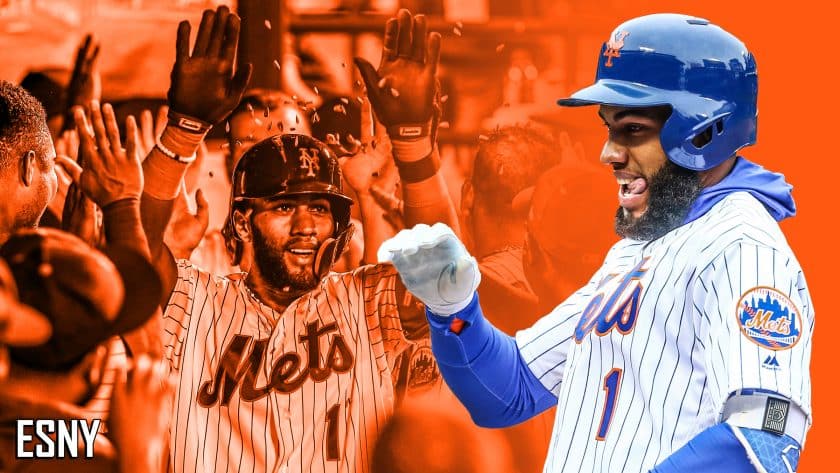The hole in the New York Mets lineup nobody wants to talk about

Amed Rosario is still a major question mark for the New York Mets and any decline in production could leave a gaping hole in the lineup.
Amidst the flurry of offseason activity that’s making the National League East seem more and more daunting every day, one thing should give New York Mets fans hope: their young core. Even after losing Zack Wheeler, the Mets have one of the strongest young, homegrown groups in baseball.
In Michael Conforto, Brandon Nimmo and J.D. Davis—depending on where they stick him—they have three strong outfielders. Pete Alonso and Jeff McNeil, of course, captain the infield, while some combination of Robinson Cano and the ghost of Jed Lowrie should hold down second base. But at shortstop, much as the Mets would like to ignore it, they may have a problem.
Amed Rosario had a career year last season. The problem is, that career year still wasn’t all that good. Among qualified shortstops, Rosario ranked 15th in baseball with a 100 wRC+, meaning he was an almost exactly average hitter. He was 18th in home runs and ISO, meaning he didn’t hit for all that much power. His 2.7 fWAR ranked 15th, right in the middle of the pack.
Let’s be clear: If Rosario can repeat his 2019 numbers in 2020, while not spectacular, they’ll be fine.
But what if he can’t?
For Rosario, something turned at the 2019 All-Star Break. After batting .260/.299/.414 in the first half of the season, he hit .319/.351/.453 during the second half. The two halves together yielded a .287/.323/.432 stat line, and a 102 OPS+.
Not great, not terrible. But what if Rosario’s true levels are closer to where he was in the first half than in the second? Rosario’s batting average on balls in play (BABIP) in the first half was .313. Meanwhile, in the second half, it rose to .363, for a season-long BABIP of .338. For some hitters, a .338 BABIP is easily sustainable. J.D. Davis, for instance, put up a .355 BABIP last season, likely because, according to Statcast data, he hit the ball harder than almost anyone in the league.
Rosario, by contrast, found himself in the 54th percentile for hard-hit percentage and 49th for exit velocity, both around league average. League average BABIP in 2019 was .298. Rosario hit slightly more line drives than average—his line-drive rate was 22.4%, compared to a league average of 21.4%—but he also hit substantially more ground balls than average, which are more likely to turn into outs. Rosario put up a 48.3% ground ball rate, compared to a league average of 42.9%.
Of course, part of Rosario’s appeal is that he’s fast. Speed helps explain some of his high BABIP: He turns ground balls that might usually be outs into hits, as Mets fans saw when he beat out a chopper to Trea Turner for a walk-off win against the Nationals.
But speed can’t solve every problem and Rosario’s BABIP is likely to decline in 2020. But suppose the decline is minimal. Let’s say Rosario’s BABIP in 2020 is .320, still far above average given his swing profile. There’s still a problem.
Simply put, Rosario doesn’t walk enough. Even in the second half of 2019, when he seemed to turn things around on offense, he only walked 12 times. His .323 OBP in 2019 was already worse than ideal: any lower will be simply too low. Even if Rosario’s stats decline by only 10 points across the board, he’ll hit .277/.313/.422. Baseball-Reference projects him to bat .274/.316/.424 in 2020, and Fangraphs has him at .275/.318/.423.
What’s more, though he sometimes seemed to have found himself on defense in 2019, the numbers don’t bear it out. Rosario was worth -16 defensive runs saved (DRS) in 2019, the same as his 2018 total. His ultimate zone rating (UZR) improved but was still a negative number. For a team in a division as competitive as the NL East looks like it will be, a .275/.318/.423 season with average or worse defense may not be good enough.
Of course, Rosario might still turn things around. He’ll only be 24 in 2020, and though his high BABIP indicates a step back, with the right development in the offseason, he may well take another step forward. Pitch selection has always been a problem for Rosario, but there’s evidence that he’s improving: His chase rate has declined each season, and his swing rate at pitches in the strike zone has increased. His chase rate is still worse than league average, but if he keeps improving, he may prove himself to be the Mets’ long-term solution at shortstop.
The only problem is the uncertainty. It’s just too easy to imagine Rosario falling back in 2020, and becoming a black hole in the Mets lineup. And like Zack Wheeler, the 2020 Mets can’t afford that.
Stats courtesy of Baseball Savant and MLB.com unless otherwise stated.
I have followed New York sports passionately for almost my entire life, since I went to Shea Stadium in 2004 and saw Jae Seo lose 8-1 to the Pirates. At journalism school, I once missed covering a Land Use Committee meeting to write about Jacob deGrom's last start of the year.






